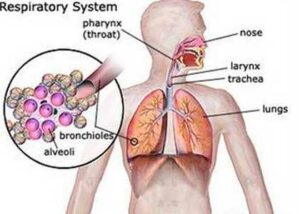What is Hypersensitivity Pneumonitis?
 What is Hypersensitivity Pneumonitis?
What is Hypersensitivity Pneumonitis?
Hypersensitivity pneumonitis, also called allergic alveolitis, is a chronic inflammatory condition of the lungs caused by an allergic sensitivity to inhaled substances such as dusts, molds, animal/bird products, and/or certain chemicals in susceptible individuals.
If the condition is recognized early and exposure to the offending agent is discontinued, the condition is reversible to some extent. However, late detection and continued exposure to the allergens can lead to scarring of the lungs and permanent loss of respiratory function.
There are more than 200 different substances which are known to cause this condition when inhaled as a fine dust for months to years. Some common examples are:
- Farmer’s Lung: Seen in cattle workers and farm workers. It is caused by the inhalation of molds from grains, straw, and hay.
- Bird fancier’s lung: This condition is also called pigeon breeder’s disease. It is due to the inhalation of small particles from the feathers and/or droppings of many different species of birds including pigeons, parakeets, canaries, chickens, ducks, and turkeys.
- Humidifier lung: It is caused by breathing in fungal spores from ill-maintained HVAC systems, humidifiers, etc.
- Hot tub lung: Water vapor from indoor hot tubs may contain bacterial products, which when inhaled, may cause chronic lung inflammation.
- Machine operator’s lung: This condition is due to exposure to contaminated metal-working fluid.
Risk Factors: People working in certain occupations are predisposed to developing hypersensitivity pneumonitis. These include farmers, dairy cattle workers, bird/poultry handlers, veterinary workers, animal handlers, cheese workers, lifeguards, grain/flour processors and/or loaders, lumber millers, wood strippers, and paper/wallboard manufacturers. Additionally, workers in paint, plastic, and adhesive manufacturing as well as some in electronic industries may be exposed to certain chemical particles which can trigger the inflammatory process of the lungs.
As most people working in above occupations do not develop hypersensitivity diseases, it is thought that certain host factors predispose some individuals to this condition. Though the exact genes have yet to be identified, most researchers believe that genetic factors play an important role in mediating susceptibility to hypersensitivity pneumonitis.
Mechanism: The condition affects the small diameter bronchial tubes that carry air and the tiny air sacs in the lungs called alveoli where gas exchange normally takes place. Inflammatory changes result in thickening of the membranes of the alveoli and the walls of the bronchial tubes. The alveoli are also filled with inflammatory exudate (i.e., the debris of dead cells, tissues, and thick mucus secretions). These structural changes will cause the interference with the normal functioning of the lungs.
Symptoms: Initial symptoms usually begin about 4 to 6 hours after inhalation of the dust. They may mimic a flu-like illness with dry cough, chills, fatigue, chest tightness/pain, and/or a mild fever. Continued and repeated exposures to the offending agents may lead to a more persistent cough, increased shortness of breath, and weight loss.
Diagnosis: Evaluation usually begins with a detailed history with special attention directed towards possible exposures to the known triggering agents. Living or working in environments containing humidifiers, hot tubs, and/or poorly maintained HVAC systems can give clues to the condition. Exposure to bird droppings or having birds as pets may suggest pigeon breeder’s disease.
Physical examination sometimes reveals abnormal breath sounds on auscultation of the lungs. Laboratory tests often demonstrate specific antibodies in the blood. A chest X-ray may show abnormal shadows caused by infiltrates. A chest CT scan is sometimes needed to detect scarring of the lungs. Pulmonary function tests provide information about the lung volumes and the amount and the velocity of air movement during normal and forced breathing. Biopsy of the lung tissue, either through a bronchoscope passed through the windpipe or video- assisted chest surgery, may be needed to confirm the diagnosis.
Treatment: Avoiding exposure to the causative dusts is critical to arrest the progress of the disease. The symptoms are usually reversible in the early stages of the disease and lung capacity and function may also recover rapidly if one is no longer exposed to the offending agents.
Medications to relieve various lung symptoms are often utilized. Cough suppressants and expectorants are generally used for a cough, while bronchodilator inhalers are used to open up the breathing tubes and relieve shortness of breath in the acute stage. Anti-inflammatory medications (e.g., oral corticosteroids) are often needed in the chronic stage to alleviate symptoms. The potential risks of long term steroid intake such as immunosuppression, weight gain, increased blood pressure, elevated blood sugar, mood changes, thinning of the bones, cataracts, and increased eye pressures (e.g., glaucoma) should be weighed against their possible benefits.
Prevention: Exposures to the disease-causing dusts can be avoided or limited by:
- Removing any standing water in and around the home or workplace. Microbes thrive in standing and still water.
- Keeping the relative humidity less than 55% at home and at work.
- Proper maintenance of heating, ventilation, and air conditioning systems.
- Removing water-logged carpeting, drywall, and furnishings.
- Drying and properly storing yard and farm equipment.
- Avoiding organic dusts such as composts.
- Wearing air purifying respirators when exposures cannot be totally avoided.
The board certified allergists at Black & Kletz Allergy have been diagnosing and treating hypersensitivity pneumonitis, sick building syndrome and other occupational diseases in the Washington, DC, Northern Virginia, and Maryland metropolitan area for more than 50 years. We have offices in Washington, DC, McLean, VA (Tysons Corner, VA), and Manassas, VA and treat both pediatric and adult patients. Together with our consistent management of allergies and asthma, Black & Kletz Allergy is very proficient in the diagnosis and treatment of occupational lung diseases such as hypersensitivity pneumonitis.












